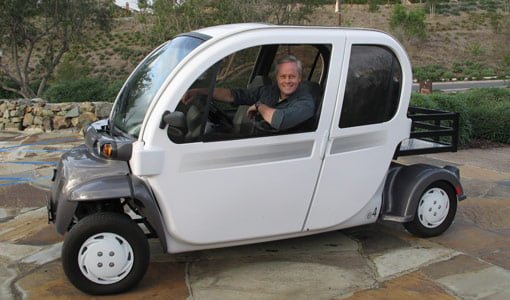

From reducing energy consumption to recycling waste, it seems like everyone is interested in doing their part to help the environment these days. While green living conserves natural resources and cuts down on pollution, it also has the practical benefit of saving money on your utility bills.
Actor and environmentalist Ed Begley, Jr. is living proof of the power of going green.
While you probably know him best from his many roles on television and film, he’s been an outspoken advocate of sustainable living for almost 40 years. Everything about his home demonstrates his commitment to treading as lightly as possible on the earth.

He’s even written a book, Living Like Ed: A Guide to the Eco-Friendly Life, about his experiences.
Sustainable Site
The first consideration in building a green house is minimizing the environmental impact to the site. Just north of San Diego, the green development of Del Sur is doing just that. Their emphasis on environmentally friendly building practices and commitment to preserving 60% of the development’s land as open space have earned Del Sur some of California’s top environmental awards.

Pervious paving of driveways, streets, and parking lots is another way to limit damage to the environment.
While pervious paving has the look and feel of concrete or asphalt, it allows rainwater to filter through and soak into the ground.

This decreases runoff that can pollute waterways and lower groundwater levels, as well as reducing the need for costly storm drains and retention ponds.
Reuse and Recycle
The Ranch House at Del Sur is both a welcome center and an example of sustainable development. Since shipping building materials long distances greatly increases their impact on the environment, many of the materials at Del Sur were obtained locally.

Walls for the Ranch House were constructed from stones found on the property while the wood flooring and the ceiling beams came from structures that were being demolished.
Nonprofit organizations like the Reuse People are given buildings that have been slated for demolition in exchange for tax deductions. They then disassemble it and resell the materials to finance their efforts. By taking the building apart piece by piece, they are able to reuse about three-fourths of the total weight and recycle much of the rest.
Companies like TerraMai in California, specialize in turning high quality wood from demolished structures into lumber for paneling, flooring, and millwork.
Since much of it comes from older, slow growing trees, the wood is stronger and more stable than lumber produced today.

Rather than tearing down older inefficient homes and apartment buildings, some developers like Marty Bhatia of OM Development, LLC in Chicago, convert them into energy efficient and environmentally friendly structures. Buyers are even provided with a manual that explains the building’s green features.

Green Products
Green building materials can be made from just about anything, including agricultural waste.
Environ Biocomposites produces a composite material made from recycled sunflower hulls known as Dakota Burl® which doesn’t emit harmful gases and can be used for a number of interior applications.

Kirei Board is an environmentally friendly product manufactured in China from sorghum stalks that remain after harvesting.
The lightweight panels have an interesting grain pattern and can be used for anything from cabinets to flooring.

Conserving Water
A family of four uses on average 400 gallons of water a day, or almost 150,000 gallons a year.
Toilets are the largest user of water in the home. Older models require up to three times the water of new high efficiency toilets such as the Persuade™ and San Raphael™ from Kohler.

Replacing an existing toilet can cut your home’s water usage by as much as 10,000 gallon a year.
Showers are another big water guzzler. Replacing a standard showerhead with a low-flow model, like the Kohler MasterShower® Ecofficient™, can save up to 20%.

Adding low-flow aerators to kitchen and bathroom faucets will help as well. Be sure to check with your local water provider to see if tax credits are available for installing water conservation devices.Another way to cut down on water usage is by funneling the runoff from your roof to a storage tank for watering your lawn.

Some systems, such as the Deluxe Potable System from Rainwater Management Solutions, can even filter the water for use in your home.
If replacing bathroom fixtures or installing a rainwater collection system isn’t in your budget, you can still cut down on water usage by repairing leaks, limiting time in the shower, and washing only full loads of clothes and dishes.
Read about and watch Going Green, Part 2
Find out more at our Going Green webpage
Other Tips From This Episode

Simple Solutions with Joe Truini:
Checking for Drafts
A simple test for air leaks is to pass a butane lighter slowly around the edges of doors and windows. If the flame bends or flickers, repair or replace the weather stripping until it remains steady. Be sure to keep the flame away from curtains or other flammable materials.

Best New Products with Emilie Barta:
n:vision Compact Fluorescent Bulbs
CFL light bulbs from n:vision carry the Energy Star rating and use 75% less energy than incandescents while delivering the same amount of light. Since they last about 10 times longer, you can expect to save $40 to $50 over the life of each bulb. For more natural looking light, choose a color temperature rating of warm or soft white. Find out more at The Home Depot.

Ask Danny:
Installing a Programmable Thermostat
I’ve heard that if you install a digital thermostat it will lower your utility bills. Is that true? -Vicki from Spanish Fort
Installing a programmable digital thermostat allows your central system to reduce heating and cooling when the house is empty. While this can save up to 15% a year on utility bills, the actual amount will vary depending on how it is set and the amount of time the house is vacant each day. If you have a heat pump, use one of the newer hybrid thermostats that are designed to work with these systems.






